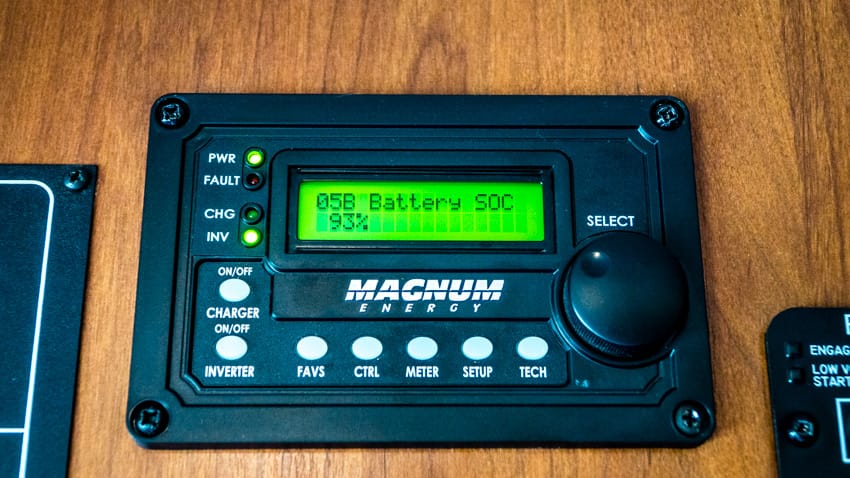How to Monitor Batteries – RV, Sailboat & Tiny Houses too

I’m going to be honest, you don’t need a Battery Monitoring Kit, but you will want one. Your battery is like a fuel tank and a BMK is the fuel gauge. Operating an RV, Sailboat or Tiny House power system without a BMK is like driving a car around without a properly working fuel gauge. You’re bound to accidentally run out of juice at some point.
We’re now transitioning from RV to sailboat and busy getting our power system set up in the boat. Our six years of RV’ing have taught us a lot about living off the grid and managing our power consumption (aka monitoring our batteries). The battery level check button that comes with most RV’s is junk. Our first three RVs didn’t have a BMK installed (and I am sure we wrecked our batteries because we didn’t). In fact, I didn’t even know what a Battery Monitoring Kit was just a couple of years ago. However, once we installed one on the Bounder, now we can’t live without it!
What the heck is a BMK? How does it work? Why is it so important to have one on my RV, Sailboat or Tiny House? We’re no experts by any stretch of the imagination, but we did our best to show you our BMK in use and answer those questions in the video below.
Our Gear
- Magnum Hybrid 3000 watt Pure Sine Inverter (you don’t have to have an inverter to use a BMK)
- BMK with Shunt
- Magnum Advanced Remote Control
- 700 Amp Hours of Lithium Battery (battery video coming soon)
Install and Setup
I’m not going to attempt to show or tell you how to setup a BMK (or attach the shunt), I called the manufacturer and their customer service walked me through the step-by-step process, and that’s what I’d recommend you do as well. I’m writing this article because so many people have asked “how do I know when my batteries are low”, “how much power can I pull from my batteries”, “what does it mean to manage your power” “What is a BMK” “Why would I want a BMK?” so I’ll attempt to answer those questions based on our experience.
The Fuel Tank Analogy
The easiest way for us to understand the BMK is to think of it as a fuel gauge. Consider the batteries your “fuel tank”. Your solar panels (or generator) would be your “gas pump”. The BMK would be the “fuel gauge” because it shows how much “fuel” is left in the “tank”, how much “fuel” is being pumped in and how much is being consumed. Most RV’s are built without a BMK which seems ridiculous, would you purchase a car without a fuel gauge? How do they expect us to know when our batteries need to be charged or “fueled up”?
The Battery Level Button is Junk
Yes, most RV’s come with a little button that you push and it shows an approximate charge level. This is a trick to make us think we are monitoring our battery level. Truth is, these meters are pretty much worthless. They might show 100% when the batteries have a false charge of only 80%. If you turn on a high draw device like a water kettle or a blow drier, it may show the batteries are instantly at 25%. How can you truly know when your battery bank reaches the harmful 50% or lower charge when the information this meter is providing is wildly inaccurate.
Biggest BMK Benefit
Every wire that touches the battery bank is wired through the Shunt: the solar, the inverter, the engine alternator, etc. The shunt and the BMK work together to give you the information you need to know about your batteries. The two most important numbers for me are the “SOC (state of charge)” and the “AH In/Out (amp hours in/out)”.
SOC is the State Of Charge of the battery bank. I type in my total battery amp hours, which is 700ah, and the BMK shows 100% SOC only when the battery bank reaches the full 700ah. Because all the wires pass through the shunt the BMK knows exactly how many amps are going into the battery bank and coming out of the batteries. Monitoring each amp is the only accurate way to know the exact battery level.
The Amp Math
In our video we ran several different devices to see how many amps they pulled from the battery bank. I could get the device wattage from the manufacturer, do a conversion from watts to amps, then come up with an approximate power draw of each device, but we like live testing to see what happens more than calculating the math on paper (we’ll avoid doing math any day).
There are plenty of free Solar Calculators out there, here’s one that we’ve used: http://gpelectric.com/go-power-calculator
A solar calculator is a good place to start your battery and solar upgrade research, but the numbers are generic and may be different from the devices you actually own. On the other hand a BMK will show the exact amp draw of each device and track the total usage throughout the day. This is why we showed the “real life” numbers in the video from the devices in our RV. Here are the devices we used along with their approximate amp draws:
- Cell Phone Charger: 0.2ADC
- Residential Fridge: 20ADC
- Hair Dryer: 80ADC
- Microwave 130ADC (we don’t actually use a microwave because we have these: Fave Kitchen Gadgets
- Dyson Hot+Cold (listed in our gear shop)
- 5ADC on Fan High
- 115ADC on High Heat
For Example
Let’s say on a chilly day of boondocking we run the Dyson heater for one hour (115 amps), the Hair Dryer for 10 minutes (8 amps), the microwave for 10 minutes (13 amps), the fridge is cooling for 20 hours of the day (400 amps) and we charge our phone for 10 hours (2 amps). Our BMK would show our battery bank as -538 amp hours or 23% SOC. That is really low.
- Lithium – Because we have lithium batteries we can drain our batteries this low (we can go as low as 10%) but we prefer to keep them 30% and above.
- Lead Acid or AGM – Led Acid or AGM batteries should NOT be drained below 50% as it drastically reduces the life of the battery and it’s ability to hold a charge.
Now let’s add solar to the mix! Let’s imagine it’s a sunny day and we’re bringing in 50 amps from 10am to 6pm with our solar kit. 8 hours of charging at this rate would put 400 amps into our battery bank. With that solar power added into the usage mentioned above, our BMK would read -138 amps or 80% SOC. That’s a lot better than 23% SOC without solar, but it’s still not 100%.
What does all this information really mean at the end of our day? We need to conserve more power. With these details we know we if we keep using this much energy we’ll continue to discharge our batteries at a rate of 20% each day, meaning we’ll be forced to run the generator which is something we don’t like to do while wild camping. Instead we’ll put on warmer clothes so we don’t need to run the heater and cook on the propane stove instead of the microwave, this small change will get our battery bank back up near 100%, which is where we like it!
As I mentioned before you can do a lot of this math without a BMK. You can manually track your usage throughout the day and can use the built in battery meter to help give you an idea of your battery consumption. For us, having the BMK to accurately monitor our battery levels is the best way to manage our use and keep our batteries from unsafe discharge levels.
We didn’t have a BMK the first several years on the road and we survived, but our batteries did not! I remember hitting ZERO on our Vesta while camping in the Mono Lake National Forest as a freezing winter storm rolled in off the nearby mountains. Our batteries were completely dead, we couldn’t run the heat, we couldn’t start the RV, we just had to bundle up and snuggle until daylight when our solar could bring in some juice to start the coach and we could head to lower elevation.
I should offer you this warning: If you take my advice and buy this BMK (virtual high fives for using our Amazon link so we get a couple pennies too) install in your RV, Tiny House or Boat…it will become an obsession! I can’t tell you how many times a day we pop up and click over to see our power usage and battery levels. I also can’t take responsibility if you or your travel partner become an unstoppable power miser. Trust me because now I have to call Nikki the power Nazi!
If you have a BMK story, or a dead battery story, please share in the comments below! If you’re still not sure what a BMK does or why it’s helpful please let me know and I will try to update this article so it makes sense for everyone (aka. I hope I didn’t ramble on too much and confuse you even more)!




